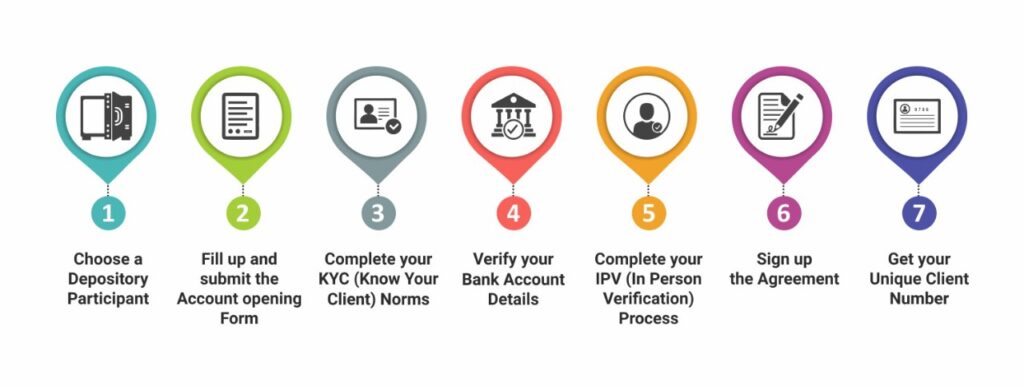
Table of Contents
How to Create a Demat Account is a crucial step for anyone interested in investing in the stock market. In this comprehensive guide, we will walk you through the process, compare the charges of popular Demat account providers, and offer tips to help you choose the best option for your needs.
1. What is a Demat Account?
A Demat account, short for Dematerialized account, allows you to hold your shares and securities in electronic form. Introduced by the National Securities Depository Limited (NSDL) in 1996, this account eliminates the need for physical certificates, reducing the risks of theft, loss, and damage.
Key Features:
- Security: Your securities are safe from physical harm.
- Easy Transfers: Moving shares becomes faster and more efficient.
- Versatility: Hold various securities such as equity, bonds, and mutual funds in one place.
2. Benefits
Owning this type of account has several advantages:
- Convenience: Manage all securities in one account.
- Paperless: No need for handling physical documents.
- Quick Transactions: Buy and sell orders are processed faster.
- Cost-effective: Lower costs compared to physical trading (e.g., stamp duty).
3. Step-by-Step Guide to Creating a Demat Account
Step 1: Choose a Depository Participant (DP). DPs include banks, brokerage firms, and financial institutions like Zerodha, ICICI Direct, HDFC Securities, and Kotak Securities.
Step 2: Fill out the account opening form on the DP’s website or at a branch.
Step 3: Submit the required KYC documents (e.g., PAN card, Aadhaar card, and a cancelled cheque).
Step 4: Undergo the verification process, which may involve in-person or video verification.
Step 5: Sign the agreement outlining the terms of service.
Step 6: Once verified, your account will be activated, and you’ll receive your account number.
Step 7: Link your trading account if you plan to trade shares.
4. Comparing Costs of Popular Providers
Here’s a comparison of charges among some of the top Demat account providers in India:
| Provider | Opening Fee | Annual Fee | Brokerage | Rating |
|---|---|---|---|---|
| Zerodha | ₹200 | ₹300 | 0.03% or ₹20 per trade | 4.5/5 |
| ICICI Direct | ₹975 | ₹700 | 0.55% per transaction | 4.2/5 |
| HDFC Securities | ₹999 | ₹750 | 0.50% per transaction | 4.3/5 |
| Kotak Securities | ₹750 | ₹600 | 0.49% per transaction | 4.0/5 |
| Angel Broking | Free | ₹450 | 0.25% per transaction | 4.4/5 |
Note: These charges can vary based on the provider and services chosen.
5. Trading vs. Investing: Understanding the Differences
When you open a Demat account, you have the option to engage in either trading or investing, or a combination of both. Here’s a breakdown of the differences:
Trading:
- Definition: Trading involves buying and selling securities over short periods, such as within a day (day trading) or over a few days (swing trading). The goal is to capitalize on short-term market movements for quick profits.
- Risk Level: Higher risk due to market volatility.
- Time Commitment: Requires constant market monitoring and quick decision-making.
- Profit Potential: High potential for quick profits, but also significant risks.
Investing:
- Definition: Investing is a long-term strategy where you buy and hold securities for extended periods, often years or decades, with the goal of gradual wealth accumulation.
- Risk Level: Lower risk compared to trading, as it focuses on long-term market trends.
- Time Commitment: Less time-intensive, as it doesn’t require daily monitoring.
- Profit Potential: Steady growth over time, leveraging compound interest and market appreciation.
Fact: According to historical data, the stock market has returned an average of 10% per year over the long term, making it a reliable method for growing wealth.
6. Choosing the Right Provider
When selecting a Demat account provider, consider:
- Costs: Compare fees and transaction charges.
- Support: Evaluate customer service quality.
- Technology: Choose a platform with a user-friendly interface.
- Reputation: Look for providers with good reviews and a solid market reputation.
- Extra Features: Consider additional services like research reports.
7. Effective Use of Your Demat Account
- Monitor Regularly: Keep an eye on your portfolio.
- Set Alerts: Use notifications for price changes.
- Secure Your Account: Use strong passwords and two-factor authentication.
- Understand Taxes: Be aware of tax implications on capital gains.
Fact: Combining both trading and investing strategies can offer a balanced approach, allowing you to take advantage of short-term opportunities while building long-term wealth.
8. Conclusion
Opening a Demat account is a straightforward process, and choosing the right provider ensures a smooth investment experience. Whether you’re new to investing or experienced, this account is essential for participating in the stock market. Understanding the differences between trading and investing will help you align your strategy with your financial goals.
9. FAQs
Q1: What documents are needed?
A: Identity proof (PAN card), address proof (Aadhaar card), and bank proof (cancelled cheque).
Q2: Can you have more than one account?
A: Yes, multiple accounts with different DPs are allowed.
Q3: Is there a minimum balance?
A: No minimum balance is required.
Q4: How long does it take to open?
A: Typically 1-3 working days after document verification.
For more content: Finance related, Applications related, Websites related.
